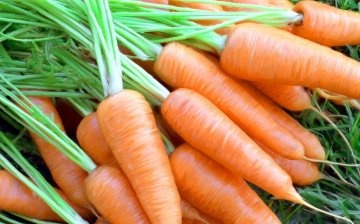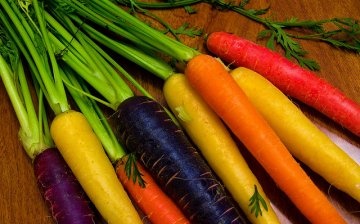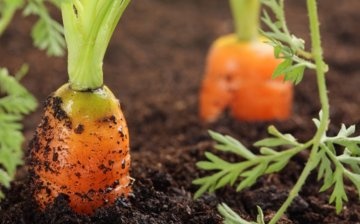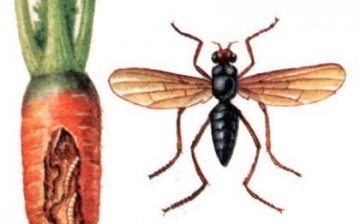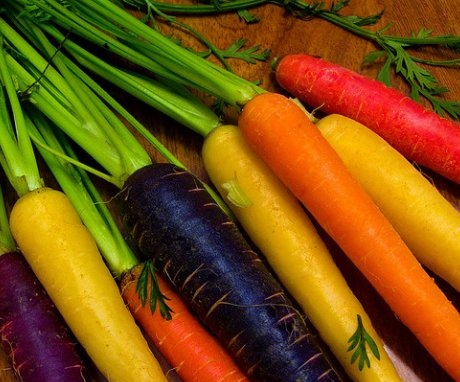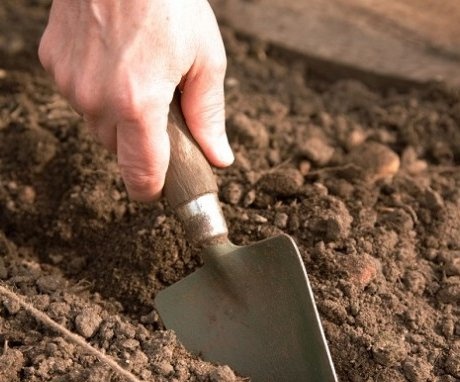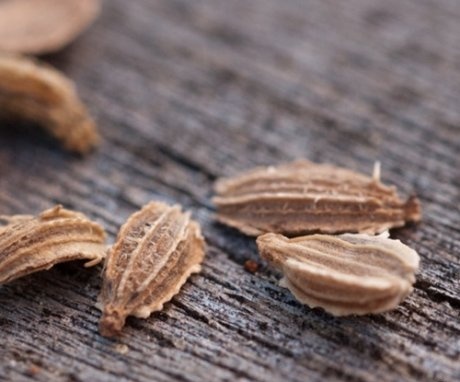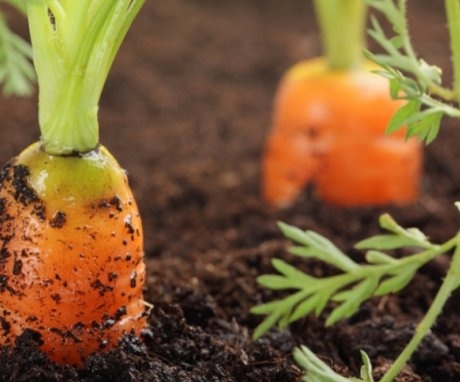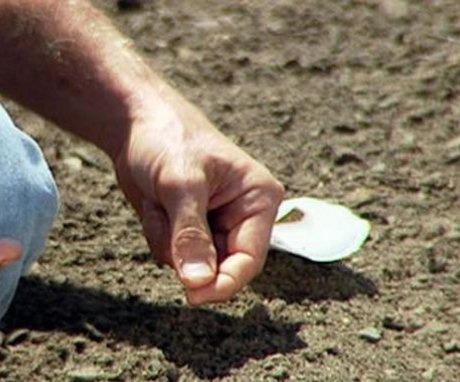How to Plant Carrots: Tips for Superior Yields
Carrot - a biennial plant from the celery family. The first year after sowing, an edible root crop is formed, in the second year the plant blooms and forms seeds. Taste, weight, shape of the root crop mainly depend on the variety and growing conditions.
Content:
- Description of carrots
- Popular varieties of root crops
- Preparing the soil for planting
- Preparing and planting carrot seeds
- Care Tips
- Sowing before winter
- Diseases and pests
Description of carrots
The root crop is formed from the root, neck and head, above which pinnately dissected, long-petiolized leaves are located. It comes in orange or yellow. There are varieties with an edible portion of black, green, purple and white. Carrot with orange flesh first appeared in Holland and is now the most common species. And purple carrots prevent the development of cancer.
Carrots are a real storehouse of vitamins and minerals.
Most of all it contains beta-carotene (vitamin A), which is necessary for the eyes and has a beneficial effect on the entire body.
Cultivated carrots are of two types:
- Canteen
- Stern
By the shape of the root, they are distinguished:
- Rounded.
- Conical.
- Cylindrical.
Popular varieties of root crops
Currently, there are more than sixty varieties of carrots. Some varieties can be planted "before winter", but they are not stored for a long time, others are planted in the spring.
Carrot varieties are classified according to the ripening time of the crop:
- Early ripening - 85 - 100 days.
- Mid-season - 105 - 120 days.
- Late ripening - 125 days or more.
For many years, the leading position has been held by gardeners recognized as the most successful varieties:
- Vitamin 6
- Nantes 4
- Losinoostrovskaya 13
- Shantane 2461
- Incomparable
- Biryuchekutskaya 415
- Moscow winter A-515
- Narbonne F1
- Nevis F1
- Flaccoro
Most of these varieties have reddish or orange roots and are shaped like an oblong cylinder, except for the varieties Chantane 2461, Flaccoro and Nespravnennaya, which have conical roots. In almost all of these types of carrots, the length of the root crops ranges from 14 to 16-17 centimeters. These ten varieties are resistant to the emergence of seed shoots (stemming).
Mid-season:
- Nantes 4 - root vegetable weight 100 grams. The sweet and juicy carrot tastes great. The variety is suitable for sowing in early and late spring and for planting before winter. Stores well until February, but is prone to white and gray rot.
- Vitamin 6 - the mass of root crops is from 60-70 to 160 grams. Sugary pulp with excellent taste. The variety is susceptible to root cracking, but is resistant to rot disease.
- Losinoostrovskaya 13 - the mass of root crops is from 70 to 150 grams. Possesses excellent taste, prone to white and gray rot, but to a lesser extent than Nantes 4. The variety is distinguished by a large amount of carotene, which increases by one and a half times during storage.
- Incomparable - root crops can reach a weight of 200 grams. The pulp has excellent taste, juicy. The variety is distinguished by excellent drought resistance, high yield... Stores well.
- Biryuchekutskaya 415 - root crops weighing 50-115 grams. The variety is not susceptible to flowering (the formation of inflorescences and seeds instead of fruits) and drought.
- Moscow winter A-515 - the mass of almost red roots is 170 grams. The variety is not susceptible to flowering, excellent storage, high-yielding, can be sown before winter.
- Narbonne F1 - roots are quite long - 20 cm, but with a small weight of 70-85 grams. The variety is not susceptible to root cracking and disease.
Late ripening:
- Shantane 2461 - weight of root crops 75-250 grams. Sweet, juicy and crispy flesh. The variety gives a high yield, is well suited for podzimny crops, excellent storage, root crops are resistant to cracking.
- Nevis F1 - root vegetable weight 130-170 grams. The variety is considered high-yielding, practically not susceptible to disease and pest resistant. Keeps perfectly. The pulp is crispy and juicy.
- Flaccoro are large root crops 25-28 cm long and weighing 150-200 grams. A high-yielding hybrid, it is well stored, differs in that it does not accumulate nitrates.
- Seeds are best purchased from shops that specialize in the sale of gardening goods, since carrots grown from seed, obtained independently, gradually degenerates.
Preparing the soil for planting
Carrots are sown in spring (April or May), early summer (early June) and before winter - in autumn (from October 25 to November 10). Carrots sown in summer are best stored in winter.
Sandy soil, slightly acidic and neutral soil are suitable for carrots.
Heavy soils form a crust that impedes the germination process and can cause root deformation. Plant a plant in the beds where it used to grow cabbage, cucumbers, potato, tomatoes, onion, which were fed during their growth with organic fertilizers.
Umbrella plants (Dill, parsley and etc.). In the fall, add humus (or rotted manure) to the garden bed under the carrots at the rate of 5 kg per 1 square meter. Fertilizer fresh manure causes deformation and branching of root crops.
You can apply mineral fertilizers to the beds:
- Superphosphate (40-50 grams per 1 sq. M)
- Ammonium nitrate (20-30 grams per square meter)
- Potassium salt (30-40 grams per square meter).
Organic fertilizers are better at increasing the volume of carotene in root crops than mineral... Carrots do not like excess mineral fertilizers. If nitrogen fertilizers are added too much to the soil, the plant accumulates a large amount of nitrates, grows too large, cracks and is poorly stored. Make beds for carrots on an area that will be well lit all day.
Preparing and planting carrot seeds
Carrots have a germination period seed large enough - 18-25 days. To speed up the germination process, as well as to prevent diseases, you can treat the seeds in one of the following ways:
- First. Place the seeds in a container of salt water (10 grams of salt per liter of water). Remove the seeds that have risen to the surface of the water, put the rest in cheesecloth and rinse thoroughly under running warm water. Then lower the seeds for ten or fifteen minutes in hot (65 ° C) water, then in cold water for the same time. Put the seeds on a damp cloth, cover and plant them in the ground a day later.
- Second. Processing is carried out in early spring. To bury in the still cold soil the seeds in a bag to a depth of 30 centimeters. Remove before sowing, dry on cloth and sow. Treated seeds will sprout within five days.
- The third. Immerse the seeds in warm water for 12 hours, which must be changed several times. Remove the seeds that float. Put the swollen seeds on cheesecloth and cover with damp gauze. After the roots appear about 0.5 centimeters long (usually after 2-4 days), the seeds can be sown.
- Fourth.Add 1 teaspoon of hydrogen peroxide (buy at a pharmacy) to 200 ml of warm water (45 ° C), dip the seeds wrapped in gauze into the solution for one day. After a day, rinse the seeds, dry and sow. This procedure disinfects the seeds and accelerates the emergence of seedlings.
- Fifth. Dissolve a micronutrient tablet in one liter of warm water (45 ° C), soak the seeds in this solution for a day, then dry without rinsing. This treatment allows you to increase the yield of carrots.
When sowing before winter, the seeds do not need to be processed. In the garden, form grooves at a distance of about 30 centimeters, compact the earth to improve seed-to-soil contact. Carrots are sown at the rate of 5 grams of seeds per 10 square meters. at a germination rate of 80% to a depth of 1.5 - 2 centimeters (with a lower germination rate, increase the number of seeds proportionally). For easier sowing, mix the seeds with sand: for one glass of sand - 1 teaspoon of seeds. Sow the third part of the mixture over one square meter. After sowing, you need to compact the soil.
The optimum air temperature for seed germination and emergence of seedlings is 15-18 degrees.
Carrot shoots easily tolerate frosts down to minus 4 degrees, but prolonged frosts cause flowering. It is not recommended to water the soil in spring, so that a crust does not form, through which it will be difficult for the sprouts to break through.
Care Tips
As carrots grow, be sure to thin out:
- Carry out the first thinning after the appearance of two true leaves - there should be 2-3 centimeters between the plants.
- The second time in about a month - leave the distance between shoots at 6 centimeters.
After the thinning procedure, feed the carrots with fertilizer: dilute in ten liters of water:
- 20-25 grams of ammonium nitrate.
- 20-25 grams of potassium salt.
- 30-40 grams of superphosphate.
To improve soil air saturation and prevent crust formation, clean regularly weeds and loosen the carrot beds. Loosening is best after watering.
To avoid the formation of bitter root vegetables with a green top, it is recommended to huddle the plants.
Water the carrots often enough, but a little and better in the evening. To prevent the root crops from cracking, watering is stopped two weeks before harvesting.
Sowing carrots before winter
Before winter, carrots are strongly recommended to be planted on sandy soils. In late autumn, it is necessary to mulch the beds with compost. Until the surface of the soil freezes, the seeds are placed at a depth of 1 cm and are not compacted. In spring, loosen the topsoil as soon as possible to slow down the evaporation of moisture and saturate the ground with air.
When sown in the fall, carrots sprout at the first spring warming, and the crop ripens two or three weeks earlier than when planted in spring.
Carrots planted before winter cannot be stored for a long time.
The disadvantage of sowing before winter is that it is difficult to guess at what time it is best to plant. If there is a warming after sowing in the fall, the seeds will germinate, and the seedlings will die in the frost.
Diseases and pests
Carrot pests:
- Main pest crops of carrots - carrot fly. To combat it, plant carrots near garlic, onions (you can alternate rows of carrots and Luke), coriander... If you see a black shiny fly with a red head on carrots, immediately sprinkle the crops with wood ash, you can mix it with pepper.
- Another pest is the carrot beetle. An insect 1.5 mm in size damages the leaf petioles, which is why they subsequently dry out. Beetroot migrates to carrot leaves from pine, so make beds for sowing under carrots away from conifers. To destroy the pest, treat the plants with infusions of tobacco dust or orange peels.
- Medvedka (brown insect up to 5 cm long) damages the roots and stems. It can be expelled with an infusion of mustard or bitter pepper. A solution of ordinary washing powder and kerosene helps.
- To destroy the carrot moth, the flowering plant is treated with a decoction of tomato tops: add 3.5 kilograms of finely chopped tops to 10 liters of boiling water, leave for two days, then strain and add 50 grams of laundry soap.
- Gall nematode damages root crops and makes them unusable. Infection with this pest occurs through seeds, so only use the services of specialized stores and do not purchase seeds "off-hand."
- The wireworm gnaws at roots and stems near the ground. To get rid of the wireworm, dig up the soil well, while adding ammonium nitrate or ammonium sulfate (30 grams per 1 square meter) to it.
- To combat naked slugs that feed on fruits and seedlings, use potassium salt mixed with slaked lime and ash.
Diseases of carrots:
- When disease with white rot, the roots are covered with a white bloom with mucus. Buy varieties of carrots that are resistant to this disease and treat the beds with potash fertilizers.
- Brown spots with dark blotches on root crops are signs of dry rot - formosis. Plant varieties that are resistant to the disease and store your carrots in a dry place.
More information can be found in the video.



